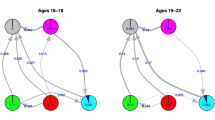Abstract
The quantitative analysis of life courses has to deal with a complex pattern of interrelated events and trajectories. Such a complex pattern needs complex measurement tools, even if only to describe the experience of cohorts. This paper addresses the methodological issue of describing the transition to adulthood from a life course perspective, following an event-based definition. New proposals are developed and traditional approaches are discussed, using Italy as an example. A generalization of survivor functions for the analysis of the temporal relationships between two events is introduced and applied. The paper then deals with the problem of describing the process of transition to adulthood as a whole, making use of the sequence analysis approach with special emphasis on the empirical analyses of the ‘standardization vs individualization’ hypotheses.
Similar content being viewed by others
References
Abbott, Andrew. 1995. Sequence analysis: new methods for old ideas.Annual Review of Sociology 21: 93–113.
Baizán Muñoz, Pau. 1998. Transitions vers l'âge adulte des générations espagnoles nées en 1940, 1950 et 1960.Genus 54: 233–263.
Billari, Francesco C. 2000.L'Analisi delle Biografie e la Transizione allo Stato Adulto. Aspetti Metodologici e Applicazioni alla Seconda Indagine sulla Fecondità in Italia. Padua: CLEUP.
Billari, Francesco C. 2001. Sequence analysis in demographic research and applications.Canadian Studies in Population 28: 439–459.
Billari, Francesco C. and Fausta Ongaro. 1998. The transition to adulthood in Italy: evidence from cross-sectional surveys.Espace, Populations, Sociétés 2: 165–179.
Billari, Francesco C., Maria Castiglioni, Teresa Castro Martín, Francesca Michielin and Fausta Ongaro. n.d. Household and union formation in a Mediterranean fashion: Italy and Spain. In M. Corijn and E. Klijzing (eds),Comparative Research on Fertility and the Family in Contemporary Europe: Findings and Lessons. Geneva: United Nations, forthcoming.
Buchmann, Marlis. 1989.The Script of Life in Modern Society. Entry into Adulthood in a Changing World. Chicago: University of Chicago Press.
Corijn, Martine. 1996.Transition into Adulthood in Flanders. Results from the FFS. The Hague: NIDI/CBGS Publications.
Courgeau, Daniel and Eva Lelièvre. 1988. Estimation of transition rates in dynamic household models. In N. Keilman, A. Kuijsten and A. Vossen (eds),Modelling Household Formation and Dissolution. Oxford: Clarendon Press.
Courgeau, Daniel and Eva Lelièvre. 1992.Event History Analysis in Demography. Oxford: Clarendon Press.
de Jong Gierveld, Jenny, Aart C. Liefbroer and Erik Beekink. 1991. The effect of parental resources on patterns of leaving home among young adults in the Netherlands.European Sociological Review 7: 55–71.
De Sandre, Paolo, Fausta Ongaro, Rosella Rettaroli and Silvana Salvini. 1997.Matrimonio e Figli: Fra Rinvio e Rinuncia. Bologna: Il Mulino.
Fuchs, W. 1983. Jugendliche Statuspassage oder individualisierte Jugendbiographie?Soziale Welt 34: 341–371.
Giele, Janet Z. and Glen H. Elder (eds.). 1998.Methods of Life Course Research. Qualitative and Quantitative Approaches. Thousand Oaks: Sage.
Hoem, Jan M. 1985. Weighting, misclassification, and other issues in the analysis of survey samples of life histories. In J.J. Heckman and B. Singer (eds),Longitudinal Analysis of Labour Market Data. Cambridge: Cambridge University Press.
Hogan, Dennis P. 1978. The variable order of events in the life course.American Sociological Review 43: 573–586.
Kerckhoff, Alan C. 1990.Getting Started. Transition to Adulthood in Great Britain. Boulder: Westview Press.
Klijzing, F.K.H. 1995. Coming of age: transitions from adolescence to adulthood. Paper presented at European Population Conference, Milan.
Liefbroet, Aart C. and Jenny de Jong Gierveld. 1995. Standardization and individualization: the transition from youth to adulthood among cohorts born between 1903 and 1965. Pp. 57–79 in H. van den Brekel and F. Deven (eds),Population and Family in the Low Countries 1994. Dordrecht: Kluwer.
Manting, Dorien. 1994.Dynamics in Marriage and Cohabitation: An Inter-temporal, Life Course Analysis of First Union Formation and Dissolution. Amsterdam: Thesis Publisher.
Marini, Margaret M. 1984. The order of events in the transition to adulthood.Sociology of Education 57: 63–84.
Marini, Margaret M. 1985. Determinants of the timing of adult role entry.Social Science Research 14: 309–350.
Marini, Margaret M. 1987. Measuring the process of role change during the transition to adulthood.Social Science Researcy 16: 1–38.
Modell, John. 1989.Into One's Oum. From Youth to Adulthood in the United States 1920–1975. Berkeley: University of California Press.
Modell, J., F.F. Furstenberg and T. Hershberg 1976. Social change and transitions to adulthood in historical perspective.Journal of Marriage and the Family 38:7–32.
Mulder, Clara and Michael Wagner. 1993. Migration and marriage in the life course: a method for studying synchronized events.European Journal of Population 9 (1): 55–76.
Mulder, Clara and Michael Wagner. 1998. First time home-ownership in the family life course: a West German-Dutch comparison.Urban Studies 35 (4): 687–713.
Ravanera, Zenaida R., Fernando Rajulton and Thomas K. Burch. 1998. Early life transitions of Canadian women: a cohort analysis of timing, sequences, and variations.European Journal of Population 14: 179–204.
Reher, David. 1998. Family ties in Western Europe: persistent contrasts.Population and Development Review 24:203–234.
Rindfuss, Ronald R. 1991. The young adult years: diversity, structural change and fertility.Demography 28 (4): 493–512.
Rindfuss, R.R., R.A. Rosenfeld and C.G. Swicegood. 1987. Disorder in the life course: how common and does it matter?.American Sociological Review 52: 785–801.
Rohwer, Görz and Ulrich Pötter. 2000.TDA User's Manual. Bochum: Ruhr-Universität Bochum.
Theil, H. 1972.Statistical Decomposition Analysis. Amsterdam: North-Holland.
van de Kaa, Dirk. 1987. Europe's second demographic transition.Population Bulletin 41, 1.
Wu, L.L. 2000. Some comments on ‘Sequence analysis and optimal matching methods in sociology: review and prospects’.Sociological Methods and Research 29: 41–64.
Author information
Authors and Affiliations
Corresponding author
Rights and permissions
About this article
Cite this article
Billari, F.C. The analysis of early life courses: Complex descriptions of the transition to adulthood. Journal of Population Research 18, 119–142 (2001). https://doi.org/10.1007/BF03031885
Issue Date:
DOI: https://doi.org/10.1007/BF03031885




